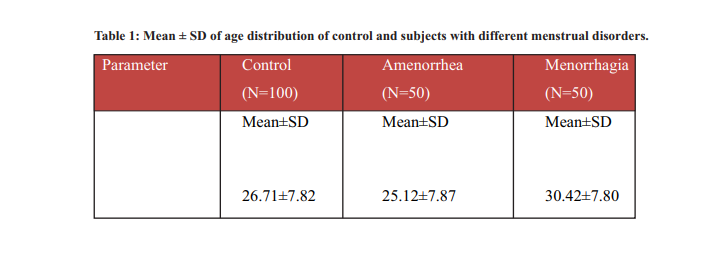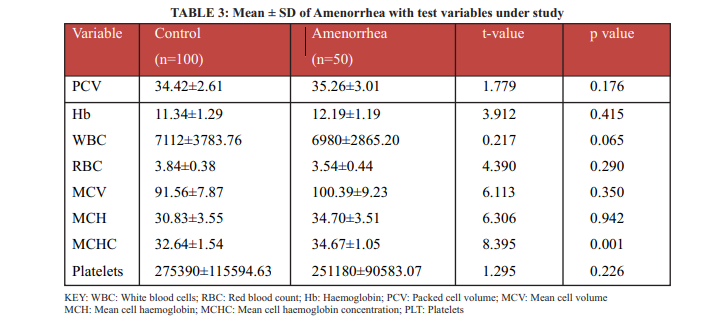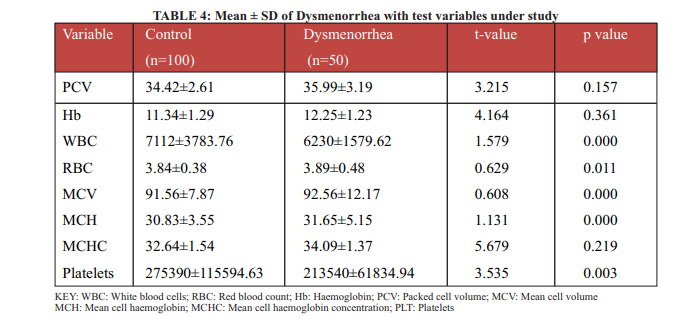EVALUATION OF SOME HAEMATOLOGICAL INDICES IN WOMEN OF REPRODUCTIVE AGE WITH MENSTRUAL DISORDERS (AMENORRHEA AND MENORRHAGIA) IN OWERRI, IMOSTATE NIGERIA
Amadi UV
Haematology Department, Federal Teaching Hospital, Owerri, Imo state, Nigeria
Okoroiwu L.I
Haematology Unit, Department of Medical Laboratory Science, Faculty of Health sciences, Imo State University, Owerri. Imo State, Nigeria
Nnodim J
Chemical Pathology Unit, Department of Medical Laboratory Science, Faculty of Health sciences, Imo State University, Owerri. Imo State, Nigeria.
Ihenacho M. C.
Haematology Department, Federal Teaching Hospital, Owerri, Imo state, Nigeria
All Corresponding to:Email:achristo40@gmail.com
ABSTRACT
Menstural disorders are problems related to a woman's normal menstrual cycle. Common Mmanifestation of menstrual abnormalities includes amenorrhea and menorrhagia. Haematological and haemostatic parameters such as haemoglobin, red blood cell count, platelets, iron, von Willebrand factor and others are altered leading to iron deficiency anaemia and bleeding complications. Analysis of its association with specific haenatological parameters is sparse in our environment. It is on this note that it becomes necessary to undertake this study.The study was carried out at Federal Medical Centre, Owerri, Imo state. The population of the study were women of reproductive age with menstrual disorders. 5mls of blood was collected by venipuncture and dispensed into an ethylene diamine tetra-acetic acid (EDTA) container. The parameters were analyzed using Sysmex Haematology Analyer KY2IN Model. When values of control subjects and menstrual disorder subjects were compared, there was a statistically significance (p<0.05) decrease observed on these parameters; RBCs, MCV, and platelets with a Pvalue of P= 0.000, P=0.000, and P= 0.014 respectively. However, the MCH, and MCHC values among menstrual disorder subjects were observed to be significantly high when compared to the control subjects, with P values of P= 0.000, P=0.000 respectively. We conclude that severe blood loss leads to decrease values of RBCs and subsequent manifestation of aneamia in menorrhagia, therefore, assessment of full blood count despite being incorporated in the panel of investigations required in the diagnosis of menstrual disorder should also be carried out as the treatment progresses.
Key words: Haematological, Menstrual, Amenorrhea Menorrhagia
INTRODUCTION
Menstrual disorders or irregularities are problems Mrelated to a woman's normal menstrual cycle. They are one of the main reasons women visit the gynaecology clinic (Kadir, 2019). It is posited that menstrual disorders and their challenges can disrupt a woman's daily life and social wellbeing ( Osayande and Mehulic, 2014) .
Abnormal menstrual patterns are diagnosed based on changes in the frequency, intensity and onset of bleeding (Osayande and Mehulic,2014). Common manifestation of menstrual abnormalities includes amenorrhea (menstrual cessation) and menorrhagia (increase frequency and volume of bleeding) (Gordon et al., 2017).
Menstrual disorders are common among women in reproductive age group and affect their normal functioning, fertility and social life (Karthik et al., 2019). According to Eric et al., (2007), approximately one third of all out-patient gynaecologic visits are undertaken for disorders of menses, making menstrual disorders some of the most common reasons women visit their gynaecologist. While most women experience menstrual discomfort or disruption during their reproductive life, more than ten percent of young women are affected for up to three days due to monthly menstrual disorder and nearly fifty percent of them go through painful menstruation frequently (Aisha et al., 2020). Besides that, abnormal uterine bleeding which is one the dangerous menstrual disorders affect about five to fifteen percent of women of reproductive age (Aisha et al., 2020).
Menstrual disorders are common health challenges but with greater burden than any other gynaecological complaints (Olowokere et al., 2014). Asmaa et al., 2020, noted that haematological and haemostatic parameters such as haemoglobin, red blood cell count, platelets, iron, von Willebrand factor and others are altered leading to iron deficiency anaemia and bleeding complications; while hyper/hypo-thyroidism and hormonal imbalance can lead to infertility and abnormal uterine bleeding (Omidvar et al., 2016). Correct diagnosis of menstrual disorder is the first step to its proper management. Despite the fact that several written reports about menstrual disorders and its association with haematological indices exist, elaborate analysis of its association with specific haenatological parameters is sparse in our environment. It is on this note that it becomes necessary to undertake the evaluation of some menstrual disorders (amenorrhea and menorrhagia) in women Owerri, Imo state
Materials and Methods Study area
The study was carried out at Federal Medical Centre, Owerri. Owerri is located in the South East of Nigeria. It is 0 the capital of Imo State. It lies on latitude 5 281 59'' north 0 Longitude 7 011 49'' north east and 159 meters above sea level (Adeleye, 2014) A cross sectional study design was adopted
The population of the study were women of reproductive age with menstrual disorders (amenorrhea and menorrhagia attending the gynaecology clinic of Federal Medical Centre, Owerri; female students of Imo State University and Alvan Ikoku College of Education both in Owerri. They were grouped into three. Group 1 were women of reproductive age without menstrual disorders (control) and Group 2 were women of reproductive age with menstrual disorders (amerorrhea) and group 3 were women with menstrual disorders (menorrhagia). Both subjects and controls met the inclusion criteria.
Simple random sampling method was adopted to select the study participants who met the inclusion criteria and also consented to the study. A sample size of One hundred apparently healthy women within reproductive age group were used as control group while a sample size of 50 each were used for the various menstrual disorders. In all, 200 samples were used for the study. The purpose of the research was explained in details to all participants to make informed choices in taking part in the research. Questionnaires were administered in the form of interviews to obtain demographic data and other subject's history.This research was carried out in agreement with the international guiding principles for research involving humans, (CIOMS,2016). A letter of introduction was collected from the head of department of medical laboratory science, Imo State University and submitted to the Medical Director of of Federal Medical Centre Owerri. On request, a proposal detailing my work was submitted to the Ethical committee of the hospital. Ethical clearance was obtained from the ethical committee of the hospita
Participant information sheet (PIS) were given to the prospective participants. After reading and understanding the PIS, questions were asked and proper explanation given. Those that consented to participate duly signed the consent form Participant information sheet (PIS) were given to the prospective participants. After reading and understanding the PIS, questions were asked and proper explanation given. Those that consented to participate duly signed the consent form. .
Sample collection, preparation
About 5mls of blood was be collected by venipuncture and dispensed into an ethylene diamine tetra-acetic acid (EDTA) container
Laboratory analysis
Sysmex Haematology Analyer KY2IN Model was used to assay white blood cell count, red blood cell count, platelet count, haemoglobin concentration and red blood cell indices
The operating principle of haematology analyzers uses the coulter impendence method. This method counts cells by detecting and measuring changes in electrical impendence when a particle in a conducting liquid passes through the aperture.
For each cell passing through the aperture, there is a constant current flowing between the external and internal electrodes and causes some changes in the impendence in the conductive blood cell suspension. These charges are recorded as increases in the voltage between the electrodes. The number of pulses is proportional to the number of particles. The intensity of each pulse is proportional to the volume of that particle. For the haemoglobin measurement, the sample is lysed, diluted and measured photometrically. The reagent lyses the red blood cells which releases haemoglobin. The chemical process forms a stable form of methaemoglobin and is measured by a photometer in the chamber and the result is displayed on the screen
Statistical analysis
The data obtained from this study were analyzed using SPSS inc version 20.0
Results
Table 1 Mean ± SD of age distribution of control and subjects with different menstrual disorders
The mean ages of control subjects, amenorrhea and menorrhagia subjects were 26.71±7.82, 25.12±7.87, 30.42±7.80, respectively.

Table 2: Mean ± SD values of Haematological variables in menstrual disorders and controls
There were significantly lower Mean ± SD values of RBC, MCV, and Platelet (p=0.000, p=0.000 and p=0.014 respectively) in subjects with menstrual disorders when compared with the control subjects. The menstrual disorders and control values respectively are 3.62 12 ±0.48/3.84±0.38×10 /Lfor RBC, 97.56±7.8/97.67±10.61fl for MCV and 246870±80667/275390±11594 for platelets
The Mean ± SD values of MCH, and MCHC were significantly higher in menstrual disorders (p=0.000 and p=0.000 respectively) when compared with the control subjects with values of 33.69±4.22/30.83±3.55pg and 34.50±1.22/32.63±1.54g/dl (Table 2)

TABLE 3: Mean ± SD of Amenorrhea with test variables under study There as significant difference in the values of Table 2: Mean ± SD values of Haematological variables in menstrual disorders and controls. There were significantly lower Mean ± SD values of RBC, MCV, and Platelet (p=0.000, p=0.000 and p=0.014 respectively) in subjects with menstrual disorders when compared with the control subjects. The menstrual disorders and control values respectively are 3.62 12 ±0.48/3.84±0.38×10 /Lfor RBC, 97.56±7.8/97.67±10.61fl for MCV and 246870±80667/275390±11594 for platelets. The Mean ± SD values of MCH, and MCHC were significantly higher in menstrual disorders (p=0.000 and p=0.000 respectively) when compared with the control subjects with values of 33.69±4.22/30.83±3.55pg and 34.50±1.22/32.63±1.54g/dl (Table 2) PT (p=0.000) and MCHC (p=0.001) in amenorrhea when compared to the control subjects, whereas other variables were statistically insignificant (p>0.05).

TABLE 4: Mean ± SD of Dysmenorrhea with test variables under study
Comparison of values of PT, FIB, WBC, RBC, MCV, MCH and Platelets in dysmenorrhea showed significant difference (p=0.001, 0.001, 0.000, 0.011, 0.000, 0.000, and 0.000) respectively when compared with the control subjects. Other compared variables showed no significant difference with p>0.05.

Discussions
In this current study, the effects of menstrual disorders were clearly demonstrated on some of the haematological, parameters under study. One of the major findings in this study was that menstrual disorders adversely affected haematological parameters either as an increase or decrease in value. There were significantly lower values of RBCs, MCV and platelets. In the first values where mean values of control subjects and menstrual disorder subjects were compared, there was a statistically significance (p<0.05) decrease observed on these parameters. The reason for reduced RBCs, MCV and Platelets levels in menstrual disorder has been attributed to excessive blood loss and prolonged bleeding. Menorrhagia being a menstrual disorder impacts negatively on the coagulation abilities of the subjects resulting in excessive blood loss. The decrease in platelet number might be related to platelet and bleeding disorders (Amesse et al., 2013).The haematological parameters with decreased values were the RBCs, MCV, and platelets when compared with the control, with a Pvalue of P= 0.000, P=0.000, and P= 0.014 respectively . Our findings are in agreement with the findings of Hutspardol et al., 2010 who also reported a lower platelet level in a work done in Thailand
However, the MCH, and MCHC values among menstrual disorder subjects were observed to be significantly high when compared to the control subjects, with Pvalues of P= 0.000, P=0.000 respectively. Amenorhhoea is the absence of Menses for a period of three months or more. Absence of menstrual blood loss could be responsible for the increase in Hb and PCV and subsequently MCHC. Menorrhagia is a menstrual disorder which involves abnormally prolonged or heavy menstrual bleeding lasting more than seven days
In menorrhaegia, the value of MCV, and MCHC were significantly higher when compared with the control subjects with P values of P=0.023 and P=0.001 respectively. Similar results was also obtained by Chimbira et al., (1979).
In all our comparisons, the WBC values of test subjects were significantly lower (P>0.05) than that of controls. These results were contrary to the findings of Sanverdi, et al., 2018 and Kim,et al.,2011 that saw a raised value in amenorhea
Conclusion
The conclusion of our study is that severe blood loss leads to decrease values of RBCs and subsequent manifestation of aneamia in menorrhagia. therefore, assessment of full blood count despite being incorporated in the panel of investigations required in the diagnosis of menstrual disorder should also be carried out as the treatment progresses.
References
- Adeleye, D.R., (2014). Sedimentology of Fluvial bida Sandstones (Cretaceous) Nigeria. Sediment Geo, 12:1-24.
- Aisha, M.A., Hammond, A.F., Huda, K.M., (2020). Menstrual disorders among nursing student at AL Neelain University Kmartiun State. Sudan Journal of Medical Science. 15(2): 199-214.
- Asmaa, S.A., Mohanned, A., Shaima, S.A., (2020). The impact of menstrual periods on performance of female workers. Journal of Women's Health Care. 9(1): 483.
- Chimbira, T. H., Cope, E., Anderson, A. B., & Bolton, F. G. (1979). The effect of danazol on menorrhagia, coagulation mechanisms, haematological indices and body weight. BJOG: An International Journal of Obstetrics & Gynaecology, 86(1), 46-50.
- Eric, R.S., Mikael, N.B., (2007). General Gynaecth cology, 13 Edition, Churchill Living stone, London. Pp: 201
- Gordon, C.M., Ackerman, K.E., Berga, S.L., (2017). Functional Hypothalamic Amenorrhea. An endocrine society of clinical practice and practice guideline
- Hutspardol, S., Sirachainan, N., Soisamrong, A. and Atchararit, N. (2010). Haemostatic defects in Thai Adolescents with menorhagea. Journal of the Medical Association of Thailand. 93(4): 1121-1127.
- International Ethical Guidelines for Health-related Research involving Humans, Fourth Edition. Geneva. Council of International Orgaizations of Medical Services (CIOMS). 2016.
- Kadir, R.A., Edlund, M., Von Mackensen, S. (2010). The impact of menstrual of menstrual disorders on quality of life in women with inherited bleeding disorders. Haemophilia, 16(5): 832-839
- Karthic, B.L., Ramya, S. and Sitanslu, S.K., (2019). Menstrual Disorders and quality of life of women in an urban area of puduchemy. A community based cross sectional study. Journal of Family Medicine and Primary Care. 8(1) 137-140.
- Kim, H. L., Cho, H. Y., Park, I. Y., Choi, J. M., Kim, M., Jang, H. J., & Hwang, S. M. (2011). The positive association between peripheral blood cell counts and bone mineral density in postmenopausal women. Yonsei medical journal, 52(5), 739.
- Olowokere, A.E., Ogini, M.N., Olajubu, A.O. (2014). Menstrual disorders, the implications on health and academic activities of female undergraduates in a federal university in Nigeria. Journal of Nursing Education and Practice. 4(5): 126-135.
- Omidar, S., Backonei, F., Amiri, F.N. and Begum, K. (2016). Primary dysmenorrheal and Menstrual Symptoms in Indian Female Students. Global Journal of Health Science. 8: 135-144.
- Osayande, A.S., Metrulic, S. (2014). Diagnosis and initial management of dysmenorrheal. Annals of Family Physician. 89(5): 341-346.
- Sanverdi, I., Kilicci, C., Cogendez, E., Abide Yayla, C., & Ozkaya, E. (2018). Utility of complete blood count parameters to detect premature ovarian insufficiency in cases with oligomenorrhea/ amenorrhea. Journal of Clinical Laboratory Analysis,32(5), e22372.




Comments are closed.